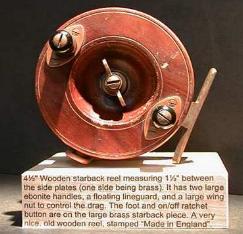
To early man, catching fish was an important food-gathering activity. As far as we can tell, however, fishing was never a chore. Then, as now, it always involved excitement, use of imagination and intellect. Just when the primary reason for fishing became sport, rather than a means of survival, is impossible to determine.The fish hook was one of man’s earliest tools. Originally, it was used as a gorge, an inch or so in length and made from wood, bone or stone, sharpened at both ends. The baited gorge was jammed into the fish’s mouth when the line attached to the middle of the shank was pulled. The advent of metal-working stimulated the manufacture of the first metal fish hooks, which were tied to a line made from animal or vegetable fibre. Longbefore the winch became available to anglers,the line was attached to the top of a hazel stick .
or was held in the hand on a spindle which had a crude wheel at one end which held the line (cat gut)and the handle through its centre the wheel floated on the shaft and could be held either in the centre between the anglers two hand using his thumbs to apply preasure two slow the wheel from spinning as a fish spead off or pushed to the end and the slack line wound back onto the wheel by batting the wheel with your free hand the line was passed through a wire loop at the top of the stick.casting was just a matter of swinging out your hook and feelined bait and letting it drop into the water.The winch ,barrel,engine,as the early reels were known as.was developed early in the seventeenth century,the winch evovled into the multi-plier type reels and the spindle was transformed into basic centre-pin reels made of wood and fixed to a long hazel stick or a bamboo pole.The use of the reel was first referred to in English angling literature in Thomas Barker's The Art of Angling (1651).By the 17th century, it was discovered that it was possible to use a longer, running line which gave better control over a large fish. In 1667, Thomas Barker mentions a salmon line of 26 yards in length, necessitating some form of winder or reel (though the Chinese had designed one by the end of the 13th century). Technical advances were accepted slowly, as evidenced in 1726 by references to the existence of rods with rings along their length and the use of a ‘winch or wheel’, although it was added that such devices were not in common use. And then just over a hundred years ago the craftsmen of nottingham took these early crude fishing wheels and produced the classic wooden Nottingham Centre-pin reels with the brass star backplate to stop the reel from warping and adding strength and inproved the central pin's material and made it more free running.these reels where then made more and more ornate and several veriations were made by individual craftsmen.The first modern looking centre-pin was made in 1896, when Henry Coxon developed the idea after being inspired by the 'new' spoked bicycle wheel. Henry Coxons' original reel had a wooden back and ebonite drum
this developed, with the engineering expertise of one Samuel Allcock and became the match aerial. The basic principle of the reel revolving on a tiny bearing surface where the tip of the centerpin has contact with a central adjusting screw was a stroke of genius. It allowed anglers to fish with finer tackle than they had been previously able to, and in the right hands they could also be used to cast considerable distances. To manage this casting required an element of skill. Subsequently the development and increased availability of the fixed spool reel allowed anglers to abandon these skills in favour of the easy long distance casting that the fixed spool reel offers and for many years centerpin reels fell out of favour with the general angling public. Today this situation has changed and many anglers are rediscovering that the centerpin when used in the right circumstances can be much more efficient that the fixed spool reel. More to the point they can be a lot more fun to use, controlling a float when trotting and playing fish directly without gears in the way are two of the lovely experiences that the centerpin offers.Fortunately coarse fishing techniques have gone full circle and when our forefathers first used the reliable Nottingham reel the only lines available were plaited silk, in effect braided line. These lines were ideal for the centre-pin as they had no stretch and were thin and strong ensuring perfect presentation. Of course those early lines had their faults and were not reliable, especially as you had to wet them before use and then make sure they were perfectly dried out after use.old centre-pins where constructed from wood with brass fittings and some where made entirely from brass then came the baker-lite ones and metal ones eventually we came to the modern centre-pin reels engineered out off aluminium as either full faced or frame type reels with spokes
Copyright © 2006 Steven Devereux. All Rights Reserved.